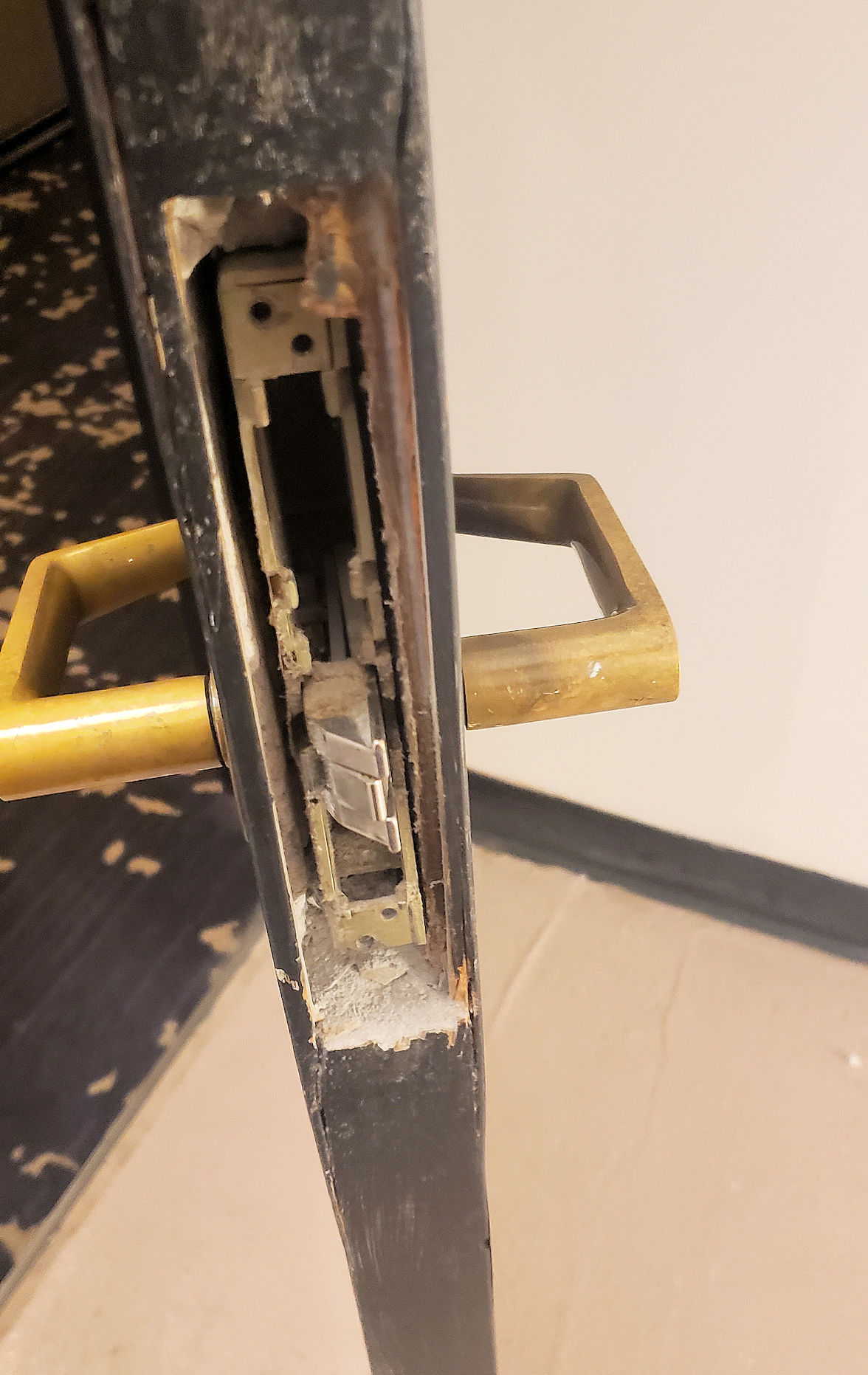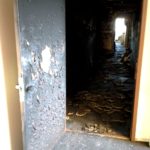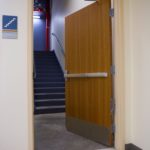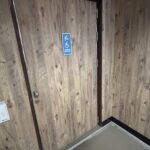 I received this photo of a fire door in a hotel stairwell from Gabriel Montoya of Jansen Ornamental Supply. You might be thinking to yourself, “This doesn’t leave me wordless…I see stuff like this all the time!”
I received this photo of a fire door in a hotel stairwell from Gabriel Montoya of Jansen Ornamental Supply. You might be thinking to yourself, “This doesn’t leave me wordless…I see stuff like this all the time!”
That’s the point. We all see fire doors that are in desperate need of repair. Fire doors that don’t close or latch, assemblies with non-listed components, non-code-compliant alterations, excessive clearances…I think I could find a problem with more than half of the fire doors that I see.
So what’s the big deal? I’ll tell you. Fire door assemblies have a very important job. If they are not maintained properly and inspected annually, and deficiencies repaired without delay, they can’t do their job. If a fire occurs and the fire partitions, fire barriers, and fire walls have 3-foot x 7-foot openings without proper opening protectives (fire door assemblies), the walls can’t provide the necessary compartmentalization.
Fires happen. According to NFPA, there were 490,500 structure fires in the US in 2020. These fires resulted in 2,730 civilian fire deaths, 13,000 civilian fire injuries, and $12.1 billion in direct property damage.
Fire door assemblies play an important role. As part of the passive fire protection system, these assemblies help to compartmentalize the building and contain a fire to one area, reducing oxygen to the fire, and protecting the means of egress to allow building occupants to escape.
Fire door inspections are required by the model codes. These inspections are mandated after installation, after maintenance work, and annually. Without the inspections, the existing deficiencies are much less likely to be repaired.
Will the door in this photo stay latched during a fire, protecting the stairwell as a means of egress for people on the floors above? There’s no way to know, and that’s what leaves me wordless.
You need to login or register to bookmark/favorite this content.









There is probably not a building In my city that I would not condemn or at least fine for violation of fire codes . This nonsense is out of hand . Especially now as inspections are only done when there is a complaint 1
The bigger crime is the fire departments won’t back us up. City of Richmond is the worst.
I’ve told firefighters if they plan to ride a fire in a stairwell that most likely, their buddies would be pulling their bodies out. Very sad
Door looks old enough it could potentially could have asbestos in the mineral core contaminating the whole entire building.
I believe the biggest issue is the lack of inspections and implementation of the codes by the respective governmental agencies. I had a meeting last week here in Calgary Alberta, where a City Fire Safety Code Inspector, told me the following “As long as I have a current Verification Inspection Report from a licensed inspection company, the city will not look into any complaints against a building!” In other words, Industry, police thy self… Which we all know never ends in a good outcome. We have no back-up from the city, when we go and report to the building owners, property management companies or condo boards to enforce the codes even from 10 years ago…. There is no political will to enforce the codes, again as the inspector said in the same conversation, “If we were to enforce the codes, over 95% of the multi-resident buildings in the City of Calgary, would fail the inspections!” What a comment to make, admitting the City of Calgary, AB does not care about people’s lives, only the fact that they can keep the Fire Department’s budget cuts. The only way we can actually get change, I think, is to inform the insurance agencies, that many buildings do not meet even the minimum codes and the insurance companies as a whole tell these small minded people, they no longer have any building insurance, as all insurance policies have disclaimers for voiding insurance if the building does not meet the minimum codes.
That’s a real shame, Jim. 🙁
– Lori
One of the most frustrating conversations I was ever involved with, an Inspector telling me sorry, we will not enforce….
How can we get the building owners, condo boards and property managers to get on board with the changes, when the people who are paid to enforce the codes will not do as they are paid….
Sad world we are living in, until someone dies from one of these doors failing when they are needed to work, nothing will happen.
I think the insurance companies may be the key, but how do we help them understand?
– Lori
I am hoping to connect with a representative from the local insurance association in the next 2 weeks, as I agree, the only way we will get the people who are at risk to understand, is for the insurance companies to get involved and maybe start cancelling Liability Policies for these buildings…..
I will keep you posted as to any updates..
Yes – let me know!
– Lori
It is sad the people ignore simple maintenance and inspections. It is normal a money issue, they feel the cost does not warrant the repair not looking at what the cost would be should a fire actually happen. It is not just existing buildings. It is also in new construction and renovations. 90% of rated openings fail my first inspection on new construction. When it comes to a renovation where a rated door is replaced in an existing frame, most contractors will walk away after the door is installed and blame any issues on the frame. The frame may indeed be the issue, but they should have checked the frame prior to getting the new door and advised the architect or client that the frame needed to be corrected or replaced before the new door could be installed. Every architect, contractor and project manager I work with hates doors and hardware. They get overwhelmed with all of the different functions and code requirements. I have even seen 3rd party inspectors pass a rated door in their inspection that clearly has issues or give incorrect information on how to correct an issue. We need stronger enforcement for all code related items, high fines for failures to get required repairs and stiff sanctions to prevent occupancy until all requirements are met.
Wow – 90%?!
– Lori
Richard. Very interesting thought on reporting to the building insurance company. This may be the reason the condo board wont give me the name of our insurance company. I live in a condo building in Libertyville, IL. The board president personally did work on the fire doors. He put kickdown hold open on each leaf of the pair of doors (doors are always in the open position), removed the flush bolt on the inactive door, installed non-rated armor plates on the doors, removed closer and installed spring hinges that don’t even close the doors from 90 degrees. (code says from 30 degrees). He posted in the board minutes that the doors now comply with NFPA and approved by the village. I had the fire chief and building code enforcement personnel out to inspect the doors and went over the violations. They refuse to acknowledge the code violations. It is truly unbelievable.
What in the world???
– Lori
Sounds like grounds for a law suit before the fact. Because they are failing to meet the code requirements they are placing your family and property at risk of loss and even death. Sometimes the only way to get action is to threaten their pocket book. Also if you are looking at moving you can try to get them to purchase your property for above market value instead of the law suit.
Did anyone inform these people that you need to replace the door and hardware after a fire, because this door looks like it’s already seen a fire.